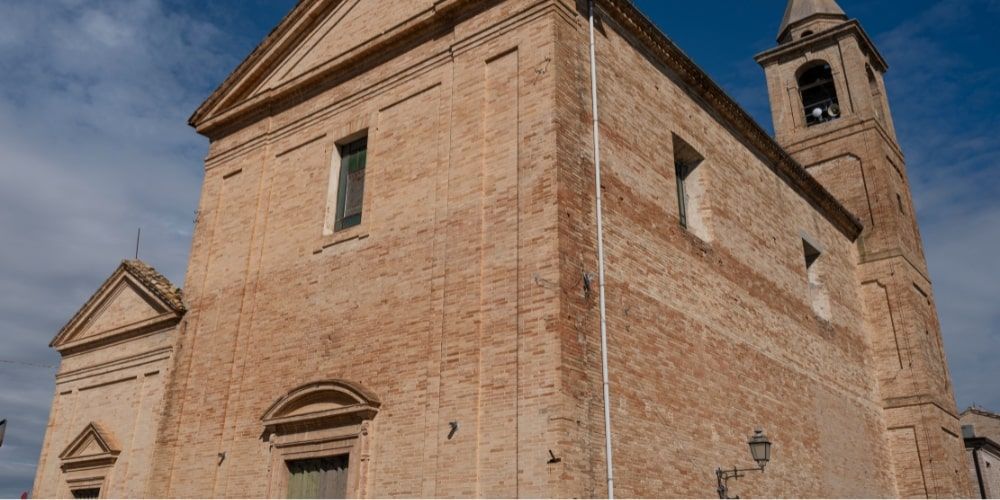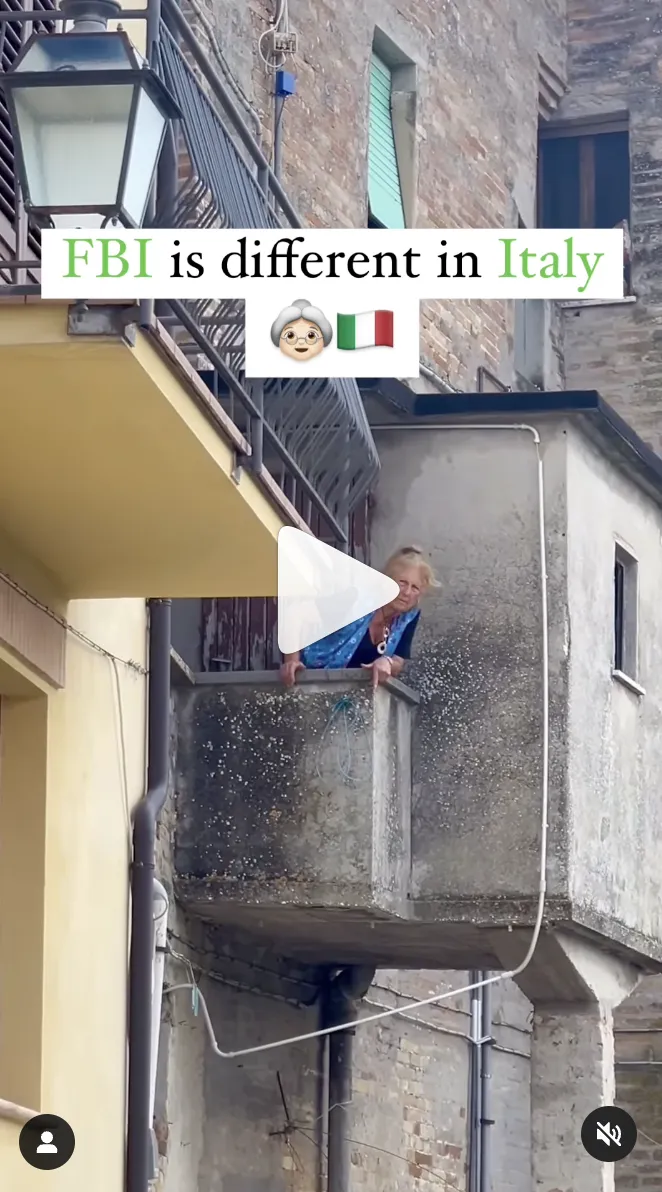Ponzano di Fermo is a village that enchants and captivates travellers seeking originality, eager to explore destinations off the beaten path and far from mainstream tourism offerings, in search of places where you can experience the warm hospitality of times gone by. It is also perfect for slow tourism enthusiasts, advocates of sustainability, and digital nomads.
This picturesque and charming location, reminiscent of the elegance, poetry, and magic of 13th- and 14th-century art, is a unique microcosm that will fascinate you with its mighty castle walls, several artworks, exquisite, ancient and majestic churches, abbeys, and castles near Ponzano di Fermo. As you stroll through its viewpoints, you'll be amazed by spectacular panoramas, ranging from the turquoise shades of the Adriatic Sea to the peaks of the Blue Mountains, offering a breathtaking kaleidoscope of colors, scents, and emotions.
The economy of this beautiful medieval village revolves around traditional rural activities, the processing of agricultural products, and branches such as footwear and small metal parts manufacturing. Perched atop a hill crest, Ponzano di Fermo offers marvelous views of the surrounding landscape, characterized by farmlands, vineyards, meadows, and coppices.
Visiting Ponzano di Fermo means embarking on an inspiring journey of discovery through a village rich in art, culture, beauty, and centuries of history. You’ll have the opportunity to admire extraordinary masterpieces, and the original creations of local workshops, and immerse yourself in the authenticity of a remarkable area worth exploring.
Where Ponzano di Fermo, mesmerizing treasure chest of artworks, is located

Ponzano di Fermo, a picturesque town sited on a hill offering astonishing naturalistic glimpses, consists of three main urban centres: the county town, and the districts of Capparuccia and Torchiaro. At an altitude of 248 metres above sea level, it expands over 14.38 square kilometres and includes three hill ridges delimited by rivers, such as the Tenna, the Rio, the Ete Vivo, the Posenzano, and the so-called Cosollo stream.
Its borders are defined to the North by the territory of Fermo, to the East by Monterubbiano and Fermo, to the South by Petritoli, and by Grottazolina and Monte Giberto to the West. Over time, Ponzano di Fermo evolved from an agricultural zone into a more artisan and residential area, shaping its current layout and fostering the development of a third urban core.




Ponzano di Fermo, embark upon a travel at the discovery of the thrilling history of this gem

According to the legend, the origins of this fairy-tale village are traced back to a disagreement between Ponziano and Gilberto, who decided to establish two distinct urban centres: Ponzano and Monte Giberto. Historically, the area has been inhabited since the 4th century A.D. and harboured a community of monks from Farfa. The oldest references of Ponzano di Fermo date back to 1059, in a deed where Longino from Suppone donated some land to Ulderico, the bishop of Fermo. The archaeological findings, including an ancient sarcophagus, a sepulchral inscription, and a Corinthian capital, are attributable to the late Roman Empire. Ponzano Castle, thanks to the Parish Church of Santa Maria Matris Domini, maintained its autonomy and territory. By 1214, Ponzano was already established as a castle, confirmed by Marquis Aldovrandino, son of Azzo d'Este, in addition to Saint Martino in Plumbarano, Montone, Longiano, and Saint Cipriano.
Throughout the 15th century, the village was ravaged by the troops of Carlo Malatesta, lord of Cesena, and later by Francesco Sforza. In 1447, it was annexed to ecclesiastical possessions, and by the late 16th century, Pope Pius V granted Ponzano di Fermo administrative independence from Fermo’s jurisdiction. During the 17th century, the town was devastated by famine, and in the 19th century, it suffered invasions by the French. The name "Ponzano" derives from the Latin name "Pontius" with the suffix "-anus." A well-known tourist attraction is the Romanesque Abbey of St. Mark, founded by the Benedictine monks and rebuilt in the 12th century. In the 15th century, Ponzano Castle rebelled against the Fermo inhabitants, enduring occupation by Malatesta soldiers. The castle of Torchiaro was also sacked and severely damaged.
In 1416, following the intervention of six citizens of Ponzano, who did their utmost to facilitate the return of the castle to the Fermo people, the village returned to the jurisdiction of the Fermo rule. In 1443, Alessandro Sforza's troops occupied the area, while the surrounding castles (Torchiaro, Longiano, Santa Maria Matris Domini, and Moregnano) were destroyed by fire. Except for Torchiaro and Moregnano, the inhabitants of the other castles sought asylum in the neighbouring castles when the General Parliament of Ponzano decided to annex the territories not yet subdivided in 1449. The present building with the entrance gate evokes the atmosphere of the 15th century.
On 28th January 1545, the current hamlet Capparuccia rose thanks to Cardinal Alessandro Farnese, nephew of Pope Paul III, who played a pivotal role. In 1569, the Castle of Ponzano sent Ser Scipione Leopardi to Rome as ambassador to ask for independence from the jurisdiction of Ponzano, claiming possession to the Holy See. With a so-called Motu Proprio, Pius V° decided to separate the Castle of Ponzano from the City of Fermo, constituting it as a land, so that it gained its municipal autonomy and the right to elect its chief magistrate. On April 5th, 1570, the local Fair of Saint Mark was instituted, where all goods could be exhibited, exempt from duties or taxes.
This historical occurrence is commemorated with the From Castle to Free District - 1570" historic reenactment Ponzano di Fermo, which takes place annually on the last Sunday of July. Over three days, the historic centre of Ponzano di Fermo comes alive with Renaissance-themed celebrations, including tournaments in antique costumes and a medieval feast. You can taste the specialties of the epoch by taking part in the Medieval dinner, enhanced by delicious 16th-century recipes. On Sunday (the last in July), the Municipal Magistrature, the Prominent Locals, the Magnificent Priors, the armourers, the Captains of Arms, and the splendid ladies re-enact the memorable event of engaging history of Ponzano to celebrate the conquest of Liberty with the Historical Procession.
The origins of the enchanting hamlet of Torchiaro

The first attestation of this established castle cited as Trocchiaro or Trocchiano, dates back to the 14th century. The area was crossed by a route of the Via Salaria, which extended from Ascoli to Petritoli and then descended toward the Ete Vivo River. At the same time, the other branch laps the surroundings of the Church of Saint Mark.
Visitors should explore the Church of Saints Simon and Judas in the historic center, rebuilt in 1827 by architect Alessandro Vassalli from Monte San Giusto. Torchiaro Castle was sacked by Malatesta troops in 1415 and by Sforza’s militia in 1443. From November 4th, 1860, it became a district of Ponzano di Fermo.
Visit the hamlet of Capparuccia

Thanks to the characteristic conformation of the territory, Ponzano extended into the Tenna plain and the hamlet of Capparuccia. The exponential transformation from an agricultural area of ancient vocation to a residential and industrial destination contributed to developing the third urban center equipped with services and shopping centers.
What to see in Ponzano di Fermo

History, art, and evocative landscape enthusiasts will be mesmerised by the extraordinary beauty of the natural views and the pictorial and archaeological masterpieces of remarkable cultural value.
Other tourist attractions include the Church of Saint Mary, the 15th-century bell tower, the fortified tower, the Castle of Ponzano di Fermo with its ramp, the Community Building, the ancient castle walls, the Museum of Popular Culture in the Tenna Valley, the Saint Mark Park, the Moscogna spring, already referred to in the cadastral documents of 1537, the Church of Saint Simon, designed and built in 1827 by the architect Alessandro Vassalli, which safeguards a precious altar in carved and gilded fir wood, the location of the Madonna delle Grazie dating back to the 18th century, the Town Council Building built in 1901 and based on Alessandro Mercuri's design.
One of the ancient castles in the province of Fermo is the hamlet of Torchiaro, which has been a part of the community of Ponzano since 1860. The urban core, nestled on a hill, is encircled by mighty walls, that conceal the majestic manor at first glance. In Torchiaro, we suggest you contemplate the 14th-century gate, the corner tower, the ancient public washhouse, the Marine Spring, the panoramic viewpoint, the castle walls, and the Church of Saints Simon and Judas.
Heading toward the hamlet of Capparuccia, you will find the Church of the Holy Heart of Jesus, another point of interest to add to your itinerary.
Explore Ponzano di Fermo and the nearby villages with this tour
Admire the Church of Saint Mark in Ponzano di Fermo
The ancient Romanesque church of Saint Maria Mater Domini, known nowadays as Church of San Marco, was built in the 12th century by monks from Farfa at the point where the second Roman Decuman gate and the 12th front cardo connect. It evokes the atmosphere and splendour of the late Roman Empire.
Visiting it, you can cherish the precious presbytery, the sarcophagus, and ancient archaeological finds dating back to 300 A.D. The present tower and front door, garnished with a valuable pointed archway and Ghibelline crenellatios, date back to the 15th century.
Contemplate the mystical Madonna delle Cataste

Exploring the Virgin Mary of Piles, locally known as Madonna delle Cataste, along the Ete Valley, near the Schito city quarter, you can explore the evocative vestiges of a church built in the early 20th century, related to apparitions of the Marian worship.
The picturesque Marine Spring and Moscogna Spring
If you walk along the ancient public road, you will catch sight of the Marine Spring. The structure, mentioned in documents drawn up in 1500, consists of two basins and a charming wash-house. Another lovely point of interest is the marvelous Moscogna Spring. During your visit to the picturesque village, the majestic castle will enchant the travellers with its magnificence.
Be allured by the evocative Saint Mary's Church

The Church of Saint Mary, designed by architect Pietro Augustoni and dating back to 1792, is one of the places of worship worth visiting. It is located on the site of the ancient Church known as Santa Maria a Pede Pontis.
The excellent handcrafted creations of Ponzano di Fermo

Typical handicrafts made in Ponzano di Fermo are influenced by the cultural and productive traditions that characterize the region. The marvellous art of creative artisans offers products of the highest quality, among which we recommend ceramics and terracotta artifacts. The main works produced in the workshops include objects, ornamental furnishings, and kitchen utensils made using ancient manufacturing techniques and recalling traditional local motifs.
The province of Fermo and the geographic area around Ponzano are also renowned for its leather processing and the handcrafted production of high-quality handmade footwear, belts, bags, and leather accessories, choosing refined materials in compliance with sustainability. The major appreciated production fields are related to the weaving and hand embroidery of tablecloths, household linen, and curtains using traditional techniques. Woodworking is also flourishing for skilfully crafting decorative objects and furniture, meticulously carved with elaborate marquetries, and wrought iron work, a valuable centuries-old art handed down from one generation to another, which features gates, interior and exterior decorations, and lamps.
Among the niche sectors, the production of cosmetics based on natural ingredients such as herbs and essential oils used to produce creams, soaps, and body oils in an environmentally sustainable way is gaining popularity. The handcrafted musical instruments, barrel organ, and accordions are another gem of this destination.
Festivals and fairs
Would you like to know the most important festivals that liven up the streets and alleyways of the lovely medieval old town? The rich calendar of events organised yearly in Ponzano di Fermo, set in the splendid landscape of the gentle hillsides, offers the curious traveller interesting ideas for savouring the festive atmosphere and the convivial character of the people from the Marche region
In July and August, the town holds some popular and heartfelt events, including the festivity of the Virgin Mary, the feast of tagliatelle flavored with wild boar sauce, and sumptuous historical re-enactments in vintage costumes. A chestnut festival and choral groups occur in the central square in October.
Among the main festivals that take place in Ponzano di Fermo, we mention the Feast of the patron saint Saint Mark, celebrated on 25th April, the Feast of the Sacred Heart in Capparuccia in the third week of June, the Festival of Evening Harmonies, which takes place during the summer months, the Stem Glasses at Saint Mark in August, the feast of fried tagliatelle held in Torchiaro, the beer and street food festival in August, and the Feast of Our Lady Divine Shepherdess, which also happens in August.
Taste the exquisite typical specialities of Ponzano di Fermo

The enogastronomic specialities of this area, strongly influenced by centuries-old farming traditions, delight the traveller, offering a wide range of typical products, and authentic delicacies to taste, from delicious caciotta to ciauscolo, from Fermanello and Fabriano salami to pit cheese, pecorino, vincotto, mistrà, from vincisgrassi to macaroni from Campofilone Igp, from Ascolan olives to typical threshing ring-shaped cake, from Fermo and Sangiorgese fish light broth and frustingo, a delicious Christmas cake made with a dough enriched with dried figs, almonds, sultanas, vincotto, aromatic spices, and fanciful candied fruit.
Among the typical dishes of the Fermano cuisine to savour in the characteristic and welcoming restaurants, hotels, and holiday farms there are some recipes, like the fried noodles of Monterubbiano, chicken livers, air-cured pork meat, fig loin, roasted goose and stewed duck, galantine made with hen and lean meats, the Fermo fried fish prepared with creams, breaded and fried meats and an olive garnish, the chestnut small log, garagoli, or cucciulìtti, wild pea soup, frappe, a sweet round fritter made for Carnival, the snake di Falerone, prepared with almonds, cinnamon, cocoa, flour, and eggs and the amandovolo, made with chocolate and almonds.
The wine-making sector offers excellent production, boasting DOCG quality assurance labels (reserved for red wines from the Montepulciano vine varieties) and white wines from the Passerina and Pecorino vine varieties. The Terra di Offida quality assurance label is a white wine from the Passerina vine variety in the raisin, sparkling, and dessert wine variants. The other most famous and appreciated wines are the Falerio DOC, produced from the Trebbiano Toscano, Passerina, the Pecorino, and the Rosso Piceno DOC, made from the Sangiovese and Montepulciano wine varietals, Anisette liqueur and the types included in the Marche IGT denomination of controlled origin.
How to get to Ponzano di Fermo

Are you wondering how to reach Ponzano di Fermo, a charming village in the Marche region? The most convenient option is to drive along the A14 motorway, exiting at Fermo/Porto San Giorgio. If you come from the North, carry on toward Ancona, instead the direction is Naples if your starting point is located in the South. Then follow the SS 16 through Porto San Giorgio, Ponte Ete-Caldarette, and the SP 56 to Ponzano di Fermo.
If you are coming from Ascoli Piceno, take the SP 235, then the Ascoli-Mare RA11 highway toward San Benedetto del Tronto and Ancona. Continue on the A14 motorway to the Fermo/Porto San Giorgio exit, then follow the SS 16 and SP 56 to Ponzano di Fermo.





